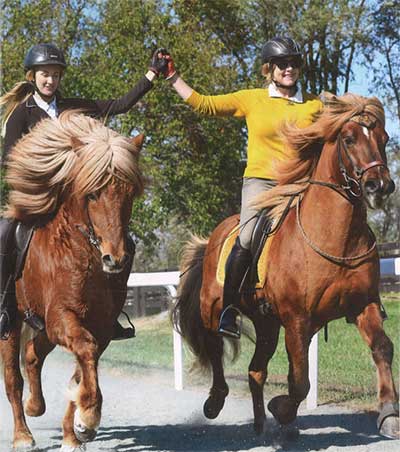Montaire Icelandic Horses Press
Northern Virginia Magazine Article
November 2023 – (reproduced with permission)
All The Pretty Horses – A Magical Farm in Middleburg Cares for Icelandic Horses
ANTJE FREYGANG SAYS SHE’S BEEN in love with Icelandic horses since she first locked eyes with one in 1992. From that day forward, the owner of Montaire Icelandic Horses, a 125-acre farm in Middleburg, has focused on elevating public awareness and understanding of the breed, not just in Northern Virginia, but all over the country and throughout the world. “I was instantly hooked; says Freygang. “Working with these gorgeous horses is all I’ve ever wanted to do; The appeal is understandable. With thick, luxurious manes and tails and long shocks of side-swept bangs (called forelocks in equestrian lingo), Icelandic horses exude a certain rockstar quality that tends to outshine other breeds. But glam is not the only thing about these beauties that turns heads. Small in stature, but mighty in every other respect, the Icelandic horse is one of the purest and oldest breeds of horses in the world. It’s surprising then, considering Virginia’s deep equestrian heritage, that so few of us have seen, or can even describe, what one looks like. One reason for this is the numbers. All breeds combined, of the estimated 60 million horses in the world, approximately 300,000 are Icelandic. About 6,647 Icelandic horses are in the United States. Of those, 3,516 are U.S.-born, and the rest are import-ed. Just about 30 are registered in Virginia. Only 20 of those reside in Loudoun County and they’re at Montaire, one of the few Icelandic horse boarding, breeding, and training facilities in the country.
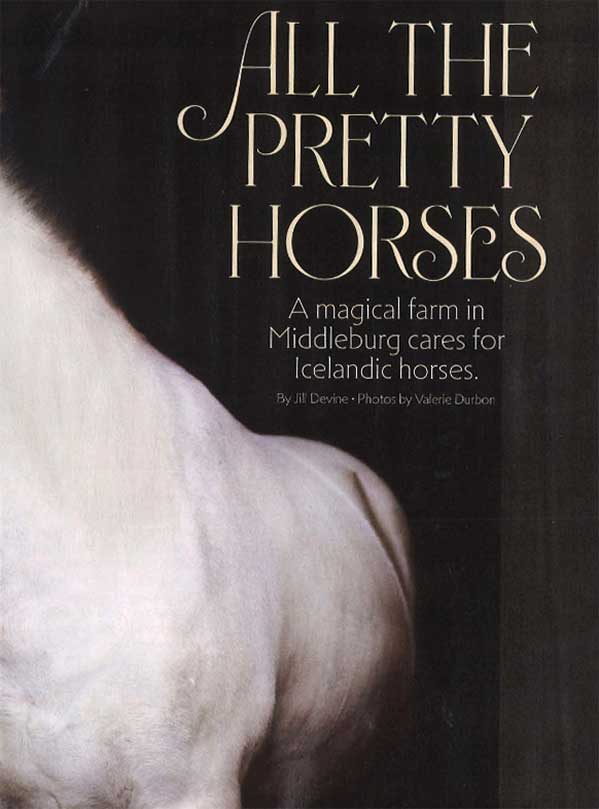
Viking History
When Viking settlers first arrived by boat in Iceland in the late 800s, they brought their best horses to navigate what they discovered was a particularly harsh terrain of glaciers, active vol-canoes, dense forests, and rushing waterfalls. For more than 1,000 years, those horses worked in isolation, and a combination of selective breeding and natural selection eventually yielded sturdy, low-to-the-ground animals with warm, thick coats and exceptional bone density. Strong and rugged enough to carry adult riders and heavy loads across lava formations and frigid waters, Icelandic horses can be fully credited with the survival of Iceland’s earliest human populations. There are no other horse breeds in Iceland, where strict laws have long prohibited imports and crossbreeding. To protect the breed’s genetic purity, once a horse leaves Iceland, it is never allowed to return. Icelandic horses receive a specific identification number at birth and are individually registered in the Icelandic government’s World Fengur database, in cooperation with the International Federation of Icelandic Horse Associations. Living for centuries with no natural predators, Icelandic horses developed exceptionally calm and trusting dispositions, making them an ideal choice for beginning riders. Because of their lifelong isolation, they are virtually disease-free and are rarely ill.
What really sets Icelandic horses apart from other breeds, however, is that in addition to the usual equine gaits of walk, trot, and canter, they have the ability to demonstrate two unique gaits based on footfall patterns: the toll, a smooth, four-beat gait especially suitable for riders with injuries or disabilities; and the flying pace, a two-beat lateral gait where riders can achieve speeds of more than 30 miles per hour. Not all Icelandic horses can achieve flying pace, but those that can are highly prized.
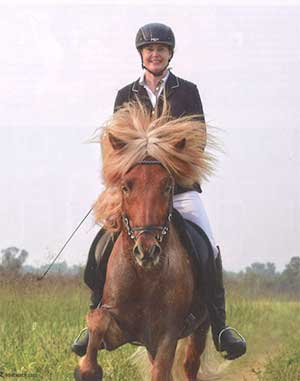
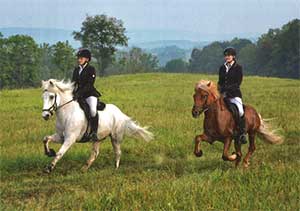
A Smooth Ride
Freygang was born and raised in Washington, DC, and has been riding all her life. She was climbing through the dressage ranks in competition and studying under renowned instructor Ulla Hudson in New Mexico in 1992 when she began having serious problems with her back. “Sitting for the extended trot on three-gaited horses became so painful, I knew I either had to stop riding or find a different breed:’ says Freygang. “Ulla came to the rescue by introducing me to Icelandic horses, which I could ride for hours without pain. I have been creating special bonds with Icelandic horses for more than 25 years now, and no other breed has taken care of me so well or offered a relationship of such mutual respect.
Don’t Call Them Ponies
Icelandic horses are admittedly petite, sizing in on average at only 13 to 14 hands, which equates to about 52 to 58 inches. “I can’t tell you how many times people who are unfamiliar with the breed have told me that I have a cute little pony,” Freygang says. Although they technically meet the height requirements of ponies, their classification as horses is based on other qualities, including strength, temperament, and con-formation. Since no other horse breed exists in Iceland, there is no word for pony in the Icelandic language, and natives there consider it a grave insult to call their horses ponies. In Iceland, young horses don’t interact with humans until they are 3 or 4 years old. Instead, owners leave them in the care of the herd as they root for grass in vast, lush pastures and drink from natural streams. “These horses trust and take care of each other; says Freygang. “It’s a lifestyle that teaches hierarchy and survival and produces extremely social animals.
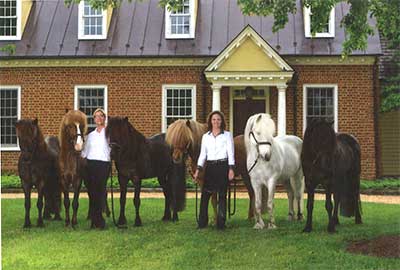
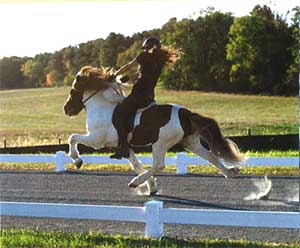
At Home in Middleburg
Freygang was still living in DC but boarding her horses in neighboring states when she had the opportunity to purchase property in Middleburg in 2015. “I bought it with plans to fill a void, because there were no facilities, trainers, farriers, or veterinarians specializing in Icelandic horses anywhere around here; says Freygang. “I was finally able to have all of my horses at home under my care and began developing and educating a support group to specialize on in 2019, Freygang launched the results of her efforts; Montaire Icelandic Horses, which offers national and inter-national trainers for both horse and rider, breeding services and evaluation, riding lessons for children and adult, horse sales and boarding, and hosts shows and competitions that attract enthusiasts from all over the country. Facilities include a regulation-sized covered riding arena, 20-meter round pen, 250-meter FEIF-sanctioned oval track, and 300-meter FEIF-sanctioned pace track, plus multiple stables, dry lot paddocks, pastures, wooded trails, and ride outs. In July, Montaire hosted the North American Youth Cup 2023, where participants competed for national rankings. Montaire is the only Icelandic horse venue in Virginia and the only one in the mid-Atlantic that meets world regulation training and showing standards. “There are only two other facilities in the United States, one in Kentucky and one in Iowa, that are comparable to us, says Freygang.
Stable Careers
Riding and caring for Icelandic horses are very popular in other parts of the world, particularly in Iceland (obviously), Germany, Denmark, Sweden, and Norway, but in the U.S., the breed is just starting to gain traction. One of Freygang’s biggest challenges is finding qualified trainers and breed specialists.
“We are so fortunate and proud to have Nicole Kempf, one of the 10 most highly decorated Icelandic horse train-ers and judges in the world, as our trainer at Montaire, says Freygang. Kempf, an award-winning, international•level rider from Germany, has been training for 35 years, the last five at Montaire.
Kempf, who is aware the breed does not have a strong base in the U.S. like it do. in Europe, says she came to Middleburg to train some of Freygang’s horses and fell in love with Virginia’s rolling farms and beautiful climate. “For me, the Icelandic horse is very special. Friendly and powerful, it is perfect for everyone — children, older people, those with injuries or disabilities,” says Kempf, would like to see more people involved, especially younger riders, which means building an education system starting with the basics,
It would be a U.S. educational system that would eventually produce top trainer, judges, and riders. With Kempf, help, Freygang says her focus going forward will be to build that system. “We are forming the building blocks fora school, one where riders learn different skills and then practice, get tested, and receive certificates as they progress. I wish I had that opportunity when I was young. My dream is to create a space for the Icelandic horse in America, to be enjoyed for many generations to come.
